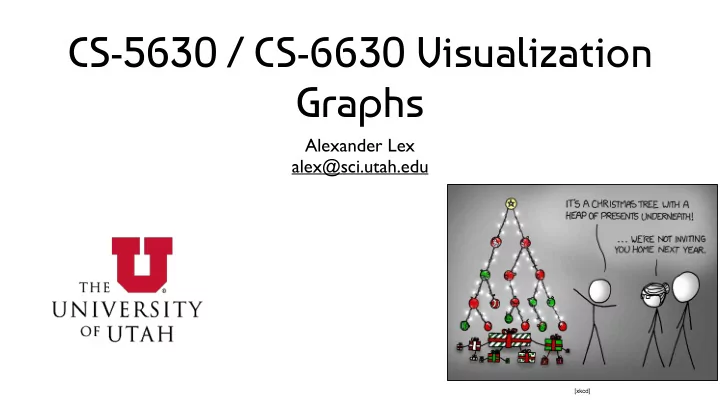

Path f inder: [EuroVis ‘16] Honorable Mention Award Visual Analysis of Paths in Graphs
Intelligence Data: How are two suspects connected?
Intelligence Data: How are two suspects connected?
Biological Network: How do two genes interact?
Photo by John Consoli Coauthor Network: How is HP Pfister connected to Ben Shneiderman?
Path f inder Visual Analysis of Paths in Large Multivariate Graphs
Path f inder Approach Query for paths
Path f inder Approach Show query result only… … as node-link diagram
Path f inder Approach Path Score Update ranking to identify important paths … and as ranked list 1. 2.
Path f inder Approach Path Score Update ranking to identify important paths 1. 2.
Query Interface
Path Representation Sets Numerical Attributes
Pathways Grouped Copy Number and Gene Expression Data
Matrix Representations
Matrix Representations Instead of node link diagram, use adjacency matrix A A B C D E A B C B C D E D E
Matrix Representations Examples: HJ Schulz 2007
Matrix Representations Well suited for Not suited for neighborhood-related TBTs path-related TBTs van Ham et al. 2009 Shen et al. 2007
McGuffin 2012
Order Critical!
Matrix Representations Pros: can represent all graph classes except for hypergraphs puts focus on the edge set , not so much on the node set simple grid -> no elaborate layout or rendering needed well suited for ABT on edges via coloring of the matrix cells well suited for neighborhood-related TBTs via traversing rows/columns Cons: quadratic screen space requirement (any possible edge takes up space) not suited for path-related TBTs
Special Case: Genealogy
Hybrid Explicit/Matrix NodeTrix [Henry et al. 2007]
Matrix Representations Problem #1: used screen real estate is quadratic in the number of nodes Solution approach: hierarchization of the representation [van Ham et al. 2009]
Implicit Layouts for Trees
Tree Maps Johnson and Shneiderman 1991
Zoomable Treemap
Example: Interactive TreeMap of a Million Items Fekete et al. 2002
Sunburst: Radial Layout [Sunburst by John Stasko, Implementation in Caleydo by Christian Partl]
Implicit Representations Pros: space-efficient because of the lack of explicitly drawn edges: scale well up to very large graphs in most cases well suited for ABTs on the node set depending on the spatial encoding also useful for TBTs Cons: can only represent trees since the node positions are used to represent edges, they can no longer be freely arranged (e.g., to reflect geographical positions) useless to pursue any task on the edges spatial relations such as overlap or inclusion lead to occlusion
Tree Visualization Reference
Visualizing Time Varying Graphs Up to now: given graphs were static Extension: given is a sequence of graphs either the sequence is given in full (offline) or the sequence is streamed (online) Variants: varying linkage: node set is fixed, only edges change over time varying a-ributes : graph structure is fixed, only attributes change
Visualizing Time Varying Graphs Animation Map time to time Layering Layout graph in 2D and use 3 rd dimension to show time Brandes & Corman 2003 For small graphs with few time steps Supergraph Aggregate all time steps into a supergraph Use colors etc. to represent time time step 1 time step 2 supergraph Aggregation Aggregation (Abstraction)
Visualizing Edge Attributes Most common ways to encode edge attributes QuanStaSve: Width Ordinal: Saturation Nominal: Style
Graph Interaction: Navigation Standard techniques e.g., overview+detail Edge-based traveling Radar view for foresighted panning [Tominski et al. 2010] [Tominski et al. 2010]
Recommend
More recommend